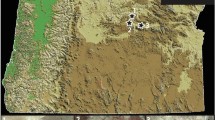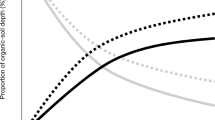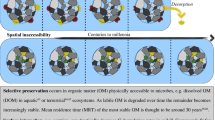Abstract
Buried soils contain large reservoirs of organic carbon at depths that are not typically included in regional and global soil carbon inventories1. One such palaeosol, the Brady soil of southwestern Nebraska, USA, is buried under six metres of loess. The Brady soil developed at the land surface on the late-Pleistocene-aged Peoria Loess in a period of warmth and wetness during which dunefields and dust sources across the region were stabilized2,3. Abrupt climate change in the early Holocene led to increased loess deposition that buried the soil4. Here, we used spectroscopic and isotopic analyses to determine the composition and stability of organic carbon in the Brady soil. We identify high levels of black carbon, indicating extensive biomass burning. In addition, we found intact vascular plant lipids in soil organic matter with radiocarbon ages ranging from 10,500 to 12,400 cal yr BP, indicating decomposition was slowed by rapid burial at the start of the Holocene. We conclude that landscape disturbance caused by abrupt climate change, fire and the loss of vegetative cover contributed to deep carbon sequestration as the soil was quickly buried under accumulating loess. We suggest that terrestrial soil carbon storage in arid and semi-arid environments could undergo landscape-scale shifts in response to rising temperatures, increased fire activity or drought.
This is a preview of subscription content, access via your institution
Access options
Subscribe to this journal
Receive 12 print issues and online access
$259.00 per year
only $21.58 per issue
Buy this article
- Purchase on Springer Link
- Instant access to full article PDF
Prices may be subject to local taxes which are calculated during checkout



Similar content being viewed by others
References
Chaopricha, N. T. & Marin-Spiotta, E. Soil burial contributes to deep soil organic carbon storage. Soil Biol. Biochem. 69, 251–264 (2014).
Mason, J. A., Jacobs, P. M., Hanson, P. R., Miao, X. & Goble, R. J. Sources and paleoclimatic significance of Holocene Bignell Loess, central Great Plains, USA. Quat. Res. 60, 330–339 (2003).
Feggestad, A. J., Jacobs, P. M., Miao, X. & Mason, J. A. Stable carbon isotope record of Holocene environmental change in the central Great Plains. Phys. Geogr. 25, 170–190 (2004).
Williams, J. W., Shuman, B., Bartlein, P. J., Diffenbaugh, N. S. & Webb III, T. Rapid, time-transgressive, and variable responses to early Holocene midcontinental drying in North America. Geology 38, 135–138 (2010).
Rumpel, C. & Kögel-Knabner, I. Deep soil organic matter—a key but poorly understood component of terrestrial C cycle. Plant Soil 338, 143–158 (2011).
Richter, D. D. & Mobley, M. L. Monitoring Earth’s critical zone. Science 326, 1067–1068 (2009).
Schmidt, M. W. I. et al. Persistence of soil organic matter as an ecosystem property. Nature 478, 49–56 (2011).
Van Oost, K. et al. Legacy of human-induced C erosion and burial on soil-atmosphere C exchange. Proc. Natl Acad. Sci. USA 109, 19492–19497 (2012).
Berhe, A. A. et al. Persistence of soil organic matter in eroding versus depositional landform positions. J. Geophys. Res. 117, G02019 (2012).
Zech, M. et al. Buried black soils on the slopes of Mt. Kilimanjaro as a regional carbon storage hotspot. Catena 112, 125–130 (2014).
Salomé, C., Nunan, N., Pouteau, V., Lerch, T. Z. & Chenu, C. Carbon dynamics in topsoil and in subsoil may be controlled by different regulatory mechanisms. Glob. Change Biol. 16, 416–426 (2010).
Sankey, J. B., Germino, M. J. & Glenn, N. F. Aeolian sediment transport following wildfire in sagebrush steppe. J. Arid Environ. 73, 912–919 (2009).
Johnson, W. C. & Willey, K. L. Isotopic and rock magnetic expression of environmental change at the Pleistocene–Holocene transition in the central Great Plains. Quat. Int. 67, 89–106 (2000).
Mason, J. A. et al. Loess record of the Pleistocene–Holocene transition on the northern and central Great Plains, USA. Quat. Sci. Rev. 27, 1772–1783 (2008).
Hockaday, W. C., Grannas, A. M., Kim, S. & Hatcher, P. G. The transformation and mobility of charcoal in a fire-impacted watershed. Geochim. Cosmochim. Acta 71, 3432–3445 (2007).
Johnson, W. C., Willey, K. L. & Macpherson, G. L. Carbon isotope variation in modern soils of the tallgrass prairie: Analogues for the interpretation of isotopic records derived from paleosols. Quat. Int. 162–163, 3–20 (2007).
Miao, x. et al. A 10,000 year record of dune activity, dust storms, and severe drought in the central Great Plains. Geology 35, 119–122 (2007).
Brodowski, S., John, B., Flessa, H. & Amelung, W. Aggregate-occluded black carbon in soil. Eur. J. Soil Sci. 57, 539–546 (2006).
Marschner, B. et al. How relevant is recalcitrance for the stabilization of organic matter in soils? J. Plant Nutrition Soil Sci. 171, 91–110 (2008).
Arbogast, A. F. Stratigraphic evidence for late-Holocene aeolian sand mobilization and soil formation in south-central Kansas, USA. J. Arid Environ. 34, 403–414 (1996).
Jacobs, P. M. & Mason, J. A. Impact of Holocene dust aggradation on A horizon characteristics and carbon storage in loess-derived Mollisols of the Great Plains, USA. Geoderma 125, 95–106 (2005).
Ohlson, M., Dahlberg, B., Økland, T., Brown, K. J. & Halverson, R. The charcoal carbon pool in boreal forest soils. Nature Geosci. 2, 692–695 (2009).
Zech, R. A permafrost glacial hypothesis - Permafrost carbon might help explaining the Pleistocene ice ages. Quat. Sci. J. 61, 84–92 (2012).
Jaffé, R. et al. Global charcoal mobilization from soils via dissolution and riverine transport to the oceans. Science 340, 345–347 (2013).
Mueller, C. W. & Kögel-Knabner, I. Soil organic carbon stocks, distribution, and composition affected by historic land use changes on adjacent sites. Biol. Fertility of Soils 45, 347–359 (2008).
Harris, D., Horwarth, W. R. & Kessel, C. V. Acid fumigation of soils to remove carbonates prior to total organic carbon or carbon-13 isotopic analysis. Soil Sci. Am. J. 65, 1853–1856 (2001).
Reimer, P. J. et al. IntCal09 and marine09 radiocarbon age calibration curves, 0–50,000 years cal BP . Radiocarbon 51, 1111–1150 (2009).
Fernández, J. M., Peltre, C., Craine, J. M. & Plante, A. F. Improved characterization of soil organic matter by thermal analysis using CO2/H20 evolved gas analysis. Environ. Sci. Technol. 46, 8921–8927 (2012).
Nelson, P. N. & Baldock, J. A. Estimating the molecular composition of a diverse range of natural organic materials from solid-state 13C NMR and elemental analyses. Biogeochemistry 72, 1–34 (2005).
Otto, A., Shunthirashingham, C. & Simpson, M. J. A comparison of plant and microbial biomarkers in grassland soils from the Prairie Ecozone of Canada. Org. Geochem. 36, 425–448 (2005).
Acknowledgements
We thank Z. R. Stewart, S. Giri, K. Wickings and C. Peltre for assistance with lab analyses, J. Sanderman for the revised molecular mixing-model, the Sturtevant family for site access, and the following funding sources: Wisconsin Alumni Research Foundation, NSF BCS-0079252, BCS-0352683, BCS-0352748. Radiocarbon analysis was graciously supported by the Radiocarbon Collaborative, which is jointly sponsored by the USDA Forest Service, Lawrence Livermore National Laboratory and Michigan Technological University. We also thank W. C. Johnson for thoughtful comments on the manuscript.
Author information
Authors and Affiliations
Contributions
E.M-S., N.T.C. and J.A.M. conceived and designed the study; N.T.C. performed soil fractionation; A.F.P. performed thermal analyses; A.F.D. performed lipid analyses; C.W.M. performed NMR analyses; A.S.G. performed pyrolysis GC/MS analyses; E.M-S. wrote the manuscript; and all authors took part in the interpretation of the results.
Corresponding author
Ethics declarations
Competing interests
The authors declare no competing financial interests.
Supplementary information
Rights and permissions
About this article
Cite this article
Marin-Spiotta, E., Chaopricha, N., Plante, A. et al. Long-term stabilization of deep soil carbon by fire and burial during early Holocene climate change. Nature Geosci 7, 428–432 (2014). https://doi.org/10.1038/ngeo2169
Received:
Accepted:
Published:
Issue Date:
DOI: https://doi.org/10.1038/ngeo2169
This article is cited by
-
Land-use induced soil carbon stabilization at the expense of rock derived nutrients: insights from pristine Andean soils
Scientific Reports (2023)
-
Accumulation of radiocarbon in ancient landscapes: A small but significant input of unknown origin
Scientific Reports (2023)
-
Alteration of rocks by endolithic organisms is one of the pathways for the beginning of soils on Earth
Scientific Reports (2018)
-
Global-scale evidence for the refractory nature of riverine black carbon
Nature Geoscience (2018)
-
Sequestration in buried soils
Nature Geoscience (2014)



